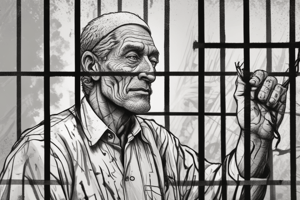Podcast
Questions and Answers
What does perception-based recording refer to in a hate crime context?
What does perception-based recording refer to in a hate crime context?
- Recording events based solely on police perspective.
- Establishing a legal definition of hate crime.
- Recording events based on the victim's or other person's perception. (correct)
- Gathering evidence from eyewitnesses only.
Which statement accurately reflects the police's approach to hate crimes?
Which statement accurately reflects the police's approach to hate crimes?
- Police may recognize hate crimes even if the victim does not. (correct)
- Police can only record incidents where a victim is identified.
- All individuals must identify as victims for an incident to be recorded.
- Hate crimes can only be reported if they involve violence.
What is a reason some individuals may not identify as victims of hate crimes?
What is a reason some individuals may not identify as victims of hate crimes?
- They are unaware of what legislation covers hate crimes.
- They may have a learning disability, dementia, or language barriers. (correct)
- They do not understand the definition of hate crimes.
- People are generally unaware of their rights.
In the context of recording hate crimes, which aspect is crucial for police to understand?
In the context of recording hate crimes, which aspect is crucial for police to understand?
Why might an incident against a building or organization be recorded as a hate crime?
Why might an incident against a building or organization be recorded as a hate crime?
Which is true regarding public perception of hate crime characteristics?
Which is true regarding public perception of hate crime characteristics?
What does Section 1(1)(a) of the Hate Crime and Public Order (Scotland) Act 2021 address?
What does Section 1(1)(a) of the Hate Crime and Public Order (Scotland) Act 2021 address?
Which scenario exemplifies an application of Section 1(1)(b)?
Which scenario exemplifies an application of Section 1(1)(b)?
What is not true about the aggravations under the Hate Crime and Public Order (Scotland) Act?
What is not true about the aggravations under the Hate Crime and Public Order (Scotland) Act?
What is the main rationale for applying the aggravations mentioned in the Act?
What is the main rationale for applying the aggravations mentioned in the Act?
In which of the following instances would Section 1(1)(a) be appropriately applied?
In which of the following instances would Section 1(1)(a) be appropriately applied?
What characterizes the motivation described in Section 1(1)(b)?
What characterizes the motivation described in Section 1(1)(b)?
Which section is specifically related to stirring up hatred?
Which section is specifically related to stirring up hatred?
What must be considered when assessing any hate crime or incidents?
What must be considered when assessing any hate crime or incidents?
Which of the following is NOT included in the criticisms or discussions exempt from being deemed abusive?
Which of the following is NOT included in the criticisms or discussions exempt from being deemed abusive?
What is a condition for material to not be deemed threatening or abusive under Section 4(2)?
What is a condition for material to not be deemed threatening or abusive under Section 4(2)?
Under Section 4(2), which activity explicitly does NOT constitute an offence?
Under Section 4(2), which activity explicitly does NOT constitute an offence?
What can be determined by the circumstances when evaluating if behavior is offensive?
What can be determined by the circumstances when evaluating if behavior is offensive?
Which statement aligns with the exemption criteria in Section 4(2)?
Which statement aligns with the exemption criteria in Section 4(2)?
What must behavior demonstrate to avoid being classified as stirring up hatred?
What must behavior demonstrate to avoid being classified as stirring up hatred?
What must be justified when hate crime is dismissed as a motive?
What must be justified when hate crime is dismissed as a motive?
What should always be included in the SPR if an interpreter is used?
What should always be included in the SPR if an interpreter is used?
How should the effect of a hate crime incident be reported in the police report?
How should the effect of a hate crime incident be reported in the police report?
What marker must be completed in the ISCJIS system for hate crime reports?
What marker must be completed in the ISCJIS system for hate crime reports?
In what situation should a statutory charge be used by the reporting officer?
In what situation should a statutory charge be used by the reporting officer?
How should police officers who experience hate crime be treated?
How should police officers who experience hate crime be treated?
What is a potential consequence for the victim reported in the hate crime incident?
What is a potential consequence for the victim reported in the hate crime incident?
What aspect is considered when assessing hate crime reports according to protocol?
What aspect is considered when assessing hate crime reports according to protocol?
What is one potential effect of Hate Crime on a community?
What is one potential effect of Hate Crime on a community?
Which term describes an incident motivated by prejudice or hostility towards an individual’s identity?
Which term describes an incident motivated by prejudice or hostility towards an individual’s identity?
How does victim perception influence the identification of Hate Crime?
How does victim perception influence the identification of Hate Crime?
What should be a fundamental approach when dealing with Hate Crime incidents?
What should be a fundamental approach when dealing with Hate Crime incidents?
Which concept is NOT part of the statutory provisions addressing Hate Crime?
Which concept is NOT part of the statutory provisions addressing Hate Crime?
What differentiates Hate Crime from a normal crime?
What differentiates Hate Crime from a normal crime?
Which of these is essential when attending a Hate Crime incident?
Which of these is essential when attending a Hate Crime incident?
What role does education play in addressing Hate Crime in the community?
What role does education play in addressing Hate Crime in the community?
Flashcards are hidden until you start studying
Study Notes
Lesson Aim
- Learners will explain statutory provisions creating substantive offences related to Hate Crime.
Learning Outcomes
- Understand the effects of Hate Crime on individuals, groups, or communities.
- Define and differentiate between Hate Crime and Hate Incident.
Incident Response
- Officers must act professionally, respecting Human Rights and Force Values during Hate Crime incidents.
- Notes should reflect the victim's perspective and be included in Crime Reports.
Perception-Based Recording
- Hate Crime can be recorded based on the perception of the victim or any witness.
- Hate Crime may be identified even without a named victim or if the victim does not recognize the incident as a hate crime.
Legislative Framework
- Hate Crime and Public Order (Scotland) Act 2021:
- Section 1(1)(a): Aggravation applies when there is a specific victim, e.g., an assault targeting a person with Down Syndrome.
- Section 1(1)(b): Aggravation applies even without a specific victim if malice is evident, e.g., anti-Semitic graffiti on a synagogue.
Aggravations
- Sections do not create new offences but enhance the gravity of existing crimes based on hateful motivation.
- Section 9 pertains to stirring up hatred but does not apply to certain discussions or criticisms under Section 4(1).
Freedom of Expression
- Freedom of expression is to be considered when assessing hate crime incidents.
- Discussions or criticisms about age, disability, sexual orientation, and religion are not inherently abusive unless intended to stir up hatred.
Reporting and Documentation
- Incidents of hate crime must be reported in compliance with ISCJIS system requirements, including a "hate crime marker field."
- Assessments should include the impact on the community and witnesses, especially if they feel unsafe due to the incident.
Language Accessibility
- Offer interpreter services for non-English speakers or those with communication needs, including sign language interpreters.
- Documentation of interpreter usage must be included in reports.
Officer Treatment
- Police personnel experiencing hate crime are to be treated as victims, receiving the same support and recognition.
Studying That Suits You
Use AI to generate personalized quizzes and flashcards to suit your learning preferences.




